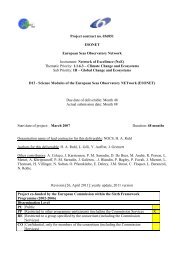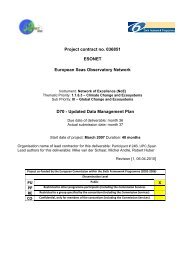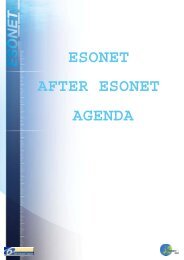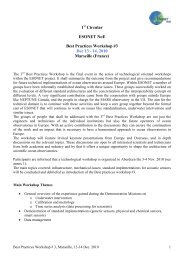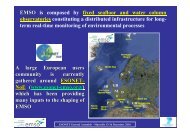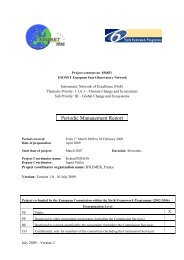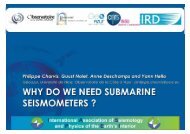Project Deliverable D50 Report on Best Practices ... - ESONET NoE
Project Deliverable D50 Report on Best Practices ... - ESONET NoE
Project Deliverable D50 Report on Best Practices ... - ESONET NoE
You also want an ePaper? Increase the reach of your titles
YUMPU automatically turns print PDFs into web optimized ePapers that Google loves.
Table 2: Generic <strong>ESONET</strong> variables in the water column and at the seafloor surface.<br />
Variable Geosciences Physical Biogeochemistry Marine<br />
Oceanography<br />
Ecology<br />
Temperature X X X X<br />
C<strong>on</strong>ductivity X X X X<br />
Pressure X X X X<br />
Dissolved O2 X X X X<br />
Turbidity X X X X<br />
Ocean currents X X X X<br />
Passive acoustics X X<br />
Table3: <strong>ESONET</strong> Sensor requirements (Please indicate if these need revisi<strong>on</strong>).<br />
Type of sensor Range Accuracy Sampling frequency<br />
C<strong>on</strong>ductivity 0 to 9 S/m 0.001 S/m 4 Hz*<br />
Temperature -5 to +35°C 0.01 K 4 Hz*<br />
Pressure 0 to 600 bar 0.1 % FSR 4 Hz*<br />
Dissolved oxygen 0 to 500μM 5% 0.01 Hz<br />
Turbidity 0 to 150 NTU 10% 1 Hz<br />
Currents 0 to 2 m/s 2% 1 Hz*<br />
Passive acoustics 50 - 180 dB re 1 μPa +/-3dB 96 KHz<br />
* high-frequency <strong>on</strong>ly needed for a few applicati<strong>on</strong>s (i.e. those related to turbulence)<br />
These generic sensors scan be used to directly address a wide range of geo-hazard warning<br />
and scientific applicati<strong>on</strong>s related to understanding natural and anthropogenic variati<strong>on</strong> and<br />
the possible impacts of climate change. The generic systems will also provide supporting data<br />
to a number of other users. Firstly these systems will be able to detect passing tsunami waves<br />
and associated low frequency sounds related to earth moti<strong>on</strong>s. In the observatory setting these<br />
data can then be relayed back to shore via seafloor cable satellite telemetry within minutes.<br />
Because nearly all tide gauges are al<strong>on</strong>g shorelines, offshore data can improve warning time.<br />
The system will be able to detect storm and tide wave loading, sedimentati<strong>on</strong> dynamics that<br />
influence turbidity such as resuspensi<strong>on</strong>, and benthic boundary layer (BBL) dynamics. By<br />
linking the tide, turbidity, and current meter readings the interacti<strong>on</strong> strengths and thresholds<br />
for resuspensi<strong>on</strong> and sediment transport can be further described. Furthermore determinati<strong>on</strong><br />
of these parameters at the seabed and in the water column can help determine how seabed<br />
processes interact with ocean circulati<strong>on</strong>, biogeochemistry, and ecological parameters.<br />
Combining the generic sensors with specific sensors such as seismometers, geodesy, bubble<br />
flux observing systems, hydrothermal flow meters and piezometers the remaining key<br />
questi<strong>on</strong>s outlined in <str<strong>on</strong>g>Deliverable</str<strong>on</strong>g> 11 can be addressed. These questi<strong>on</strong>s include; how are<br />
seismic activity, fluid pore chemistry and pressure, and gas-hydrate stability, and slope failure<br />
related? And, what are the feedbacks between deformati<strong>on</strong>, volcanism, seismic, and<br />
hydrothermal activity?<br />
The generic sensors can address fully the questi<strong>on</strong>s related to physical oceanography.<br />
However, a generic sensor module at the surface, midwater and/or at the seafloor can <strong>on</strong>ly<br />
answer these questi<strong>on</strong>s partially. The use of salinity and c<strong>on</strong>ductivity sensors spaced regularly<br />
al<strong>on</strong>g strings and additi<strong>on</strong>al ADCP coverage can, however, fully capture the themes related to<br />
ocean physics. These include understanding wind driven and deep-ocean circulati<strong>on</strong>,<br />
planetary waves, and interacti<strong>on</strong>s between the BBL and seabed. Mobile systems used in<br />
c<strong>on</strong>juncti<strong>on</strong> with the fixed infrastructures can also augment the impact of the generic sensors.<br />
<str<strong>on</strong>g>Deliverable</str<strong>on</strong>g> #50 - update October 2010 18



